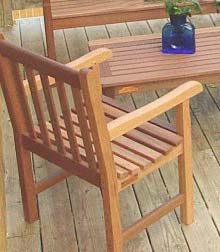
Throughout North America, summertime draws people outdoors to relax in the leafy sanctuary of their backyard decks and gardens. A bewildering assortment of garden furniture and accessories is available in a wide selection of materials, price ranges and styles. Increasingly, outdoor furniture is more stylish and functional as well as affordable and comfortable. Pieces that fold for easy storage, sleek silhouettes, innovative finishes, and the contemporary reinvention of classic designs define millennial fashions in outdoor furniture. Although maintenance-free, resin-based materials, metal and non-porous wicker are giving wood a run for the money, discerning homeowners still prefer the organic feel of traditional wooden furniture.
In the United States, cedar and redwood--both light, durable and attractive--are the preferred species for outdoor furniture and garden accessories. Oak, ash and other common hardwood species are solid, hard-wearing alternatives. Although they generally lack the sturdiness and durability of domestic hardwoods, properly stained or painted aspen, pine, Douglas fir and other softwoods, are also popular. Eucalyptus, rubberwood and a host of lesser-known tropical hardwoods are heavy, extremely rot resistant alternatives that have been making an increasingly strong showing in the marketplace.
However, only one species--teak--stands out as unmatched in its appeal and utilitarian value. It's ability to withstand the rigors of adverse climate, yet maintain its weathered look, make teak the premium choice for outdoor furniture today. Teak's appearance actually improves with age; exposed to the elements, the wood fades to a soft, stone gray that merges into the landscape. Because of its durability and beauty, teak furniture has often been specified by architects for the punishing wear and tear of public spaces. British craftsmen have used teak in traditional high-end, garden furniture since the 18th century and teak benches built over a century ago still grace London gardens from Hyde Park to Kew.
Beyond enjoying its natural beauty, few people sitting in their teak deck chairs and settees give any thought to this versatile tropical hardwood. For most Americans, price, quality and design are the primary features in selecting furniture. If they think about where the wood is coming from at all, it is assumed that it is coming from a benign source. In the case of an exotic hardwood like teak, however, the passage from the rainforests of Southeast Asia to the bench in your backyard is a tangled journey, one that might make you sit up and think about where this wood is coming from and what impact it is making locally as well as globally.
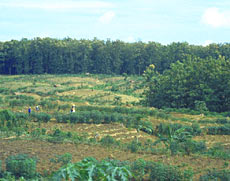 Where Teak Grows
Where Teak Grows
The scientific name for teak is Tectona grandis. The generic name is derived from the original Malaysian name for the tree, tekku, and the species name, grandis, great or large, refers to its oversized leaves that are 10- to 20 inches long and 7- to 14 inches wide: among the largest leaves of any tree. The long, oblong-shaped leaves are so rough that natives routinely used them as an abrasive, like sandpaper. A deciduous tree in the Verbenaceae family (many gardeners are familiar with the herbaceous species, vervain, in the same family), teak grows in tropical climates and prefers a long, dry season and sweet, limestone soils.
Teak occurs naturally in India, Burma, Java, and throughout Southeast Asia. It is planted extensively throughout the region and has been introduced throughout the tropical world with plantations established in Africa, the Caribbean and Latin America. In its natural habitat, old-growth teak is a magnificent tree. Normally, teak attains a height of 70- to 100 feet, but on favorable sites it reaches heights of 130- to 150 feet, rising to the canopy branchless for the first 80 feet or so. Trunk diameters are usually 3- to 5 feet, but because the base is fluted and buttressed, older trees can be as much as 6- to 8 feet in diameter with some logs weighing over 12 tons. Generally, teak does not grow in pure stands. It is scattered through the tropical forest, often with a dense understory of bamboo.
Myamaar--until recently known as Burma--has the largest reserves of teak forest in the world. The highest quality teak in the world, Myamaar's forests are under extreme environmental pressure with a relentless threat of large-scale deforestation and site degradation because of political instability. Much of the Myamaar teak wood is cut illegally and sometimes smuggled out as "dunnage" or decking on cargo ships that is subsequently ripped up and resawn as premium lumber.
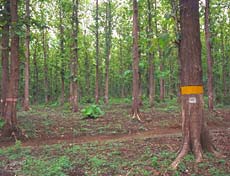 Plantation Teak
Plantation Teak
Extensive plantations of teak were established on the island of Java in Indonesia over a century ago. Originally, most of Java, one of the most densely populated countries in the world, was covered by primary forest. The Dutch East Indies Company began exploiting Java's natural teak stands shortly after its arrival in 1596 to support ship and housing construction. Despite intense agricultural pressure, large stands of primary forest remained intact until several hundred years ago. The pattern of uncontrolled exploitation continued until the close of the nineteenth century when planned and coordinated management was instituted. Kingsley-Bate, Ltd., one of America's leading manufacturers of teak outdoor furniture, was the first American company to use Javanese plantation teak in the manufacture of export-quality, outdoor furniture in the early 1980s.
Many of the major distributors of teak advertise their products as "plantation grown," implying that it does not come from a primary forest and, therefore, does not contribute to the problems associated with tropical deforestation. Because most of the island of Java was cleared for agriculture hundreds of years ago, deforestation and conversion of primary natural forest to plantation is not the central environmental issue. Traditionally, teak plantations are not established from seedlings but planted with teak cuttings called "stumps. " Teak is typically planted at a lower density than other fast growing species to take advantage of traditional agroforestry techniques such as interplanting annual row crops of soybeans or cassava, which are tended by peasant farmers every year until the shade from canopy closure makes further farming impossible. The traditional agroforestry system is called "tungyua" and has been implemented in agricultural development and reforestation projects around the world.
According to Jeff Hayward, forester and SmartWood Asia Pacific Coordinator, there are some environmental issues relating to forest management such as road building, protection of streams and use of pesticides. "However," noted Jeff, after a recent trip to Indonesia, "these are secondary problems associated with plantation grown teak. The primary problem with teak is complex and revolves around issues such as illegal harvesting of teak plantations and the social inequities with the exploitation of teak." According to public relations material, manufacturers and distributors will routinely claim that the Indonesian government allows the felling of a limited number of trees each year, and ensures that an equal amount of reforestation takes place. "This is not quite true," he notes derisively. "The rotation age for plantation teak is relatively long for a tropical species-60- to 80 years." Timber theft," he continues, "by organized syndicates and individuals reduces allowable stocking and introduces social injustice and criminal elements that cast a shadow on the sustainable production of plantation teak."
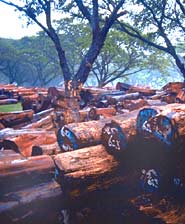 Certified Green
Certified Green
Since the early 1990s, environmental watchdogs have monitored the trade of tropical timber and wood products. In 1990, the New York-based, Rainforest Alliance, in conjunction with outdoor furniture distributors, "certified" that the wood coming from Java was being harvested in a "sustainable manner." Over the last decade, a certification system overseen by the Oaxaca, Mexico-based Forest Stewardship Council, or FSC, has been painstakingly developed by a coalition of community activists, social scientists, environmentalists and industry. Part of the certification process, is a stringent segregation system and field audit-a "chain-of-custody"-that follows the wood from stump to finished product.
Around the world, the FSC has certified millions of acres and thousands of products. One of the most active certifying organizations is a Vermont-based offshoot of the Rainforest Alliance called SmartWood. Since 1997, Smartwood has worked diligently to update the standards and re-issue the original certifications to Javanese manufacturers. Says Jeff Hayward, "Not all plantation teak is certified but only certification through SmartWood or another FSC-accredited certifier can assure the buyer that the wood in the product was not harvested illegally and follows the highest standards of forest stewardship available."
Environmental responsibility
How can you help? Consumers can have a positive impact on the protection and stewardship of world's forest habitat by selecting wood products, regardless of whether the wood is tropical or temperate, with the FSC label. Although the FSC certification process, like or any other eco-labeling scheme is imperfect, the FSC logo on a product is the consumer's best assurance that the material they are purchasing is coming from the source claimed and that the product was produced in the accordance with the highest environmental and social standards.
ScanCom International is a young Danish company that has have grown to become the largest supplier of wooden outdoor furniture in the world. ScanCom's production operations are located in Viet Nam, Indonesia and Malaysia. Typically, their furniture is made from teak and other tropical woods. During 1998, European environmental groups criticized the wooden outdoor furniture industry for not paying enough attention to the environmental aspects of their operations. Since then, ScanCom has developed an International Environmental Policy and set an ambitious target of five years to convert all their purchases to FSC-certified wood. This reflects a growing commitment of many companies that the use of wood as a raw material does not adversely affect tropical forests; the people that depend on them for their livelihoods; or the rich biodiversity they support. ScanCom also founded, in partnership with its principal customers, the Tropical Forest Trust, a non-profit company that is committed to increasing the area of FSC-certified forest in the tropics. The company also commenced a program to introduce chain-of-custody and "wood origin control" systems in all of our production facilities.
One United States company that has been a leader in environmental responsibility is San Francisco-based Smith & Hawken. Smith & Hawken has been a pioneer in the use of certified wood products and has consistently tried to source certified teak and Spanish cedar (Cedrela odorata) and lesser known species in their outdoor furniture and accessories. According to Heather Itzla, Smith & Hawken's public relations specialist, "our company carries only FSC-certified material and sells teak that is guaranteed to be ecologically grown and responsibly harvested on the Island of Java."
Consumers who prefer wood have a few other alternatives. One is to seek lesser-known wood species from community-based operations or small-scale industrial operations in developing countries. Lesser-known species assign value to otherwise degraded forest, increase the palette of options to forest managers and reduce pressure on overharvested species. The Gardener's Supply Co. carries a line of FSC-certified garden furniture from a South American species that looks and feels similar to teak. According to the importer, Paul Fuge, one of the owners of Sylvania Forest Products of Santa Fe, New Mexico, the material, roble, (Amburana caerensis) is a cheaper, durable alternative that is sustainably harvested from the lowland rainforests of Bolivia. Purchasing products utilizing reclaimed or recycled sources, so called "re-discovered wood," is another option for attractive functional pieces that feel good without taking a bite out the world diminishing forest resources.
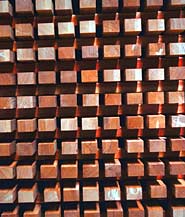 Teak: Queen of Tropical Timbers
Teak: Queen of Tropical Timbers
Teak is sometimes referred to as the queen of tropical hardwoods and according to 19th century German botanist Sir Dietrich Brandis, "...among timbers, it holds the place which the diamond maintains among precious stones and gold among metals." Teak varies from a yellow, strawlike color to rich, deep brown variegated with black streaks and a sharply demarcated, yellowish sapwood. When first cut, teak darkens with exposure to the air and has an oily surface and feels sticky to the hand with peculiar scent reminiscent old shoe leather. According to William Lincoln, British wood expert, the quality and color of the wood varies greatly with growing conditions and region. "The naturally grown teak from Burma is a uniform golden-brown color without markings but most other teak is rich brown with darker chocolate brown streaks. Indian teaks are straight or wavy grained and mottled and so oily to the touch, it is marked with white glistening deposits."
Many woodworkers claim there is a marked difference between naturally grown stands and plantation timber. Because of faster growing conditions, the rings are wider and the density and oil content of plantation-grown timber is lower. Boatbuilders, in particular, prefer the color, tight vertical grain and higher durability of slow-grown, natural teak. The weight of teak varies from 38- to 43 pounds per cubic-foot, or a little more than half an equal amount of water (specific gravity is .55). For comparison purposes, this is somewhere between white ash as red oak. The wood is kiln-dried for months to reduce water content, eliminating shrinkage or expansion that could stress joints. Teak dries slowly but once seasoned properly, it is vary stable wood with little movement in service.
Although it doesn't have the high silica content of some tropical hardwoods, blunting of tools can be rather severe and carbide cutters are recommended. It has a tendency to split and pre-boring is necessary for nailing. Teak is easily worked with both hand and machine tools but the dust can cause skin irritation. The mechanical properties of teak make it unsurpassed as a utilitarian wood used for a wide spectrum of applications: fine furniture, cabinetmaking, interior and exterior joinery, floors, exterior structural works and garden furniture. Teak is also cut for all grades of plywood. Sliced and decorative face veneers became popular in the post-war Europe with the Scandinavian style furniture and architectural interiors. It is also fire and acid resistant and has been used for chemical vats, fume ducts and laboratory benches
Teak's most outstanding characteristic, however, is its durability and high resistance to water absorption, hence its wide use in ship and boat building for decking, rails, and hatches. Another unique property is it does not cause rust or corrosion in contact with metal. The heartwood of teak is very resistant to decay fungi and termites, but is not immune to marine borers so is not generally used for posts and pilings.
Elephants and castles: Traditional Harvest of Teak
The art and science of modern forestry was virtually unknown outside middle Europe when Sir Dietrich Brandis first went to British colony of Burma in 1856. Over a period of 40 years, he established the foundation of the "Burma Selection System," one of first examples of systematic timber harvesting and a pioneering work in silviculture. Because the only practical method of bring teak timber to market was by floating it, Brandis devised a system of harvesting based on traditional Burmese methods. Until recently, no mechanized equipment was utilized in the harvest of natural teak forests and traditional harvesting methods are still the primary method of logging.
Teak, like most tropical hardwoods, is extremely dense and heavy; and unlike softwoods, it won't float unless it is practically bone dry. Therefore, teak trees are systematically "girdled." A broad circular cut is made with an ax or chainsaw through the bark and sapwood right into the dark brown heartwood. In affect, this girdling disrupts the translocation of carbohydrates and within a season or two, the tree is dead. After two or three years of drying on the stump, the trees are felled, cut into logs and dragged or "yarded" to feeder streams by oxen, water buffaloes and elephants. The yarding is done during the rainy season when the ground is moist and slippery so the heavy timber glides easier. The logs are floated singly down the smaller streams and when they reach the main stream or river they are collected and formed into rafts. Log rafts are transported to manufacturing facilities to be transformed to lumber, veneer and secondary products or gearbulked on commercial vessels for export around the world.
Care And Maintenance Of Teak
In addition to longevity, a key virtue of teak is that it is virtually maintenance-free, even with long exposure to rain, snow or strong sunlight. Teak furniture requires little to no care and will maintain its strength and attractiveness for decades. The polished appearance of teak furniture comes from oil occurring naturally in the wood. The surface oil will evaporate after a few days outdoors but it is the sub-surface oil gives that gives the wood its durability. After a short time outdoors, six to nine months, depending on the amount of exposure, the untreated furniture acquires an attractive silver-gray patina which is part of the look associated with teak.
During the weathering process, small cracks in the end grain, or lifting of the grain may occur on the top edges of the arms and legs. Called "checking," his is a natural process, as wood expands and contracts slightly when left outdoors. The grain will return to its original smooth finish after the initial weathering process and has no affect on the stability of the furniture. Water spots or other discoloration may also occur during the weathering process. These will even out, and the furniture will achieve a uniform silver-gray. Some of these oils bleed out following the first few rainfalls and care should be taken to protect cushions and upholstery until the furniture has seasoned. According to teak dealers, once the teak has this patina, it is advisable not to apply any oil at all because it may cause mildew or irregular coloring. For indoor furniture use, manufacturers suggest using Briwax or Johnson's Wax.
The only maintenance necessary for teak furniture is periodic cleaning. A leading teak dealer, Kingsley-Bate, recommends a solution of four parts laundry detergent or dish-washing soap and one part bleach applied with a soft bristle brush and thoroughly rinsed to remove the dirt and any remaining solution. For deeper cleaning the use of teak cleaner is required. To keep the furniture the original golden color, various teak sealer products will maintain the color but must be reapplied on a regular annual basis. After the furniture has weathered, these cleaners will restore the furniture to the natural golden color regardless of how long the piece has been outside.
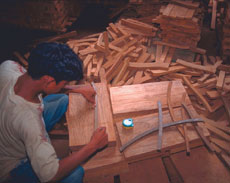 Quality and Design: Hallmarks of Craftsmanship and Conservation
Quality and Design: Hallmarks of Craftsmanship and Conservation
The design of the classic English garden furniture and contemporary transitional styles incorporate the talents of skilled wood carvers and craftsmen. Teak furniture ranges from faithful reproductions of traditional designs featuring "heirloom construction" to affordable mass-produced reproductions. People are becoming more attuned to bringing the outdoors in and the indoors out, so there's more of a flow towards practical designs, furniture that is versatile enough to use in any room in the house. A roster of world-class designers has elevated some of these innovative, limited-edition or one-of-a kind pieces to works of art. A modern interpretation of traditional styling in teak is fashioned in combination with the flowing lines of cast or extruded aluminum-a celebration of the simplicity of wood and metal.
The quality of teak furniture varies dramatically. Although lumber and furniture components are imported for construction in the United States, most of the manufacturing has shifted to the Pacific, that is Indonesia, Malaysia, and Thailand. Handmade furniture, made piecemeal buy semi-skilled laborers and family shops, is lower quality and lacks the refinement of precision machine-made furniture. Generally, better garden furniture is machine-made and manufactured with interlocking mortise and tenon joinery. Engineered to tight tolerances, the pieces are supported with solid, moisture-sealed joints and solid brass hardware. Some furniture is fully assembled but most teak furniture is sold as ready-to-assemble, and most pieces are shipped partially assembled. Some manufacturers such as California-based, Smith & Hawken, a distributor of teak furniture since the early 1980s, guarantee their teak products for 75 years.
Yuri Bihun is a forest resources specialist and the Director of Shelterwood Systems, a Vermont-based consulting firm.
Photography by Brooks Elder/National Gardening Association and Smartwood.